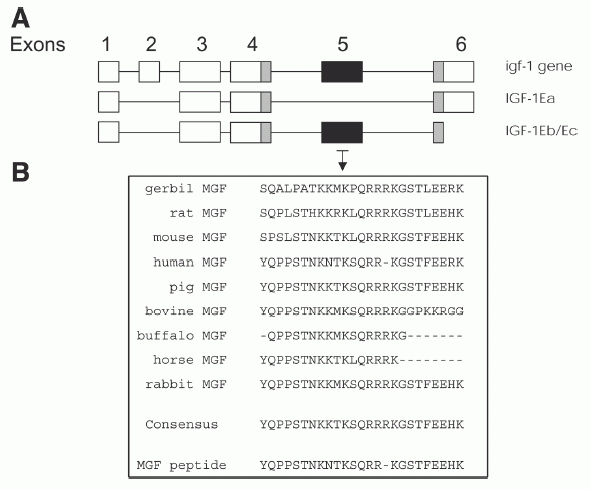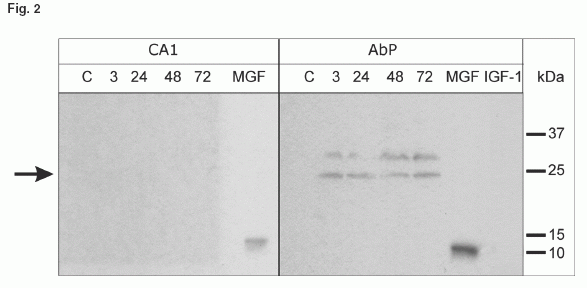
IGF-1: one gene, many proteins. A) A schematic representation of the IGF-1 gene and its locally produced splice variants. The black boxes denote the insert in exon 5 (49 bp in human, 52 bp in gerbil and other species studied), which gives rise to alternatively spliced MGF isoform. B) The gerbil C-terminal MGF peptide sequence shows a high degree of homology with E-domains from other species. Based on the consensus sequence, the C-terminal MGF peptide was synthesized.Dluzniewska J, et al. FASEB J. 2005 Sep 6; [Epub ahead of print]
The ischemic stroke is the third leading cause of death in developed countries. The C-terminal peptide of mechano-growth factor (MGF), an alternatively spliced variant of insulin-like growth factor 1 (IGF-1), was found to function independently from the rest of the molecule and showed a neuroprotective effect in vivo and in vitro. In vivo, in a gerbil model of transient brain ischemia, treatment with the synthetic MGF C-terminal peptide provided very significant protection to the vulnerable neurons. In the same model, ischemia evoked increased expression of endogenous MGF in the ischemia-resistant hippocampal neurons, suggesting that the endogenous MGF might have an important neuroprotective function. In an in vitro organotypic hippocampal culture model of neurodegeneration, the synthetic peptide was as potent as the full-length IGF-1 while its effect lasted significantly longer than that of recombinant IGF-1. While two peptides showed an additive effect, the neuroprotective action of the C-terminal MGF was independent from the IGF-1 receptor, indicating a new mode of action for this molecule. Although MGF is known for its regenerative capability in skeletal muscle, our findings demonstrate for the first time a neuroprotective role against ischemia for this specific IGF-1 isoform. Therefore, the C-terminal MGF peptide has a potential to be developed into a therapeutic modality for the prevention of neuronal damage.
Dluzniewska J, Sarnowska A, Beresewicz M, et al. A strong neuroprotective effect of the autonomous C-terminal peptide of IGF-1 Ec (MGF) in brain ischemia. FASEB J. 2005;19(13):1896-8.
The physiological function of a recently cloned splice variant of insulin-like growth factor-I (IGF-I; mechano growth factor (MGF)) was studied using an in vitro cell model. Unlike mature IGF-I, the distinct E domain of MGF inhibits terminal differentiation whilst increasing myoblast proliferation. Blocking the IGF-I receptor with a specific antibody indicated that the function of MGF E domain is mediated via a different receptor. The results provide a basis for localized tissue adaptation and helps explain why loss of muscle mass occurs in the elderly and in dystrophic muscle in which MGF production is markedly affected.
Yang SY, Goldspink G. Different roles of the IGF-I Ec peptide (MGF) and mature IGF-I in myoblast proliferation and differentiation. FEBS Lett. 2002;522(1-3):156-60.

| Catalog# | Product | Standard Size | Price |
|---|---|---|---|
| 033-35 | Mechano-Growth Factor (MGF) (Human) | 100 µg | $167 |
| 033-42 | Mechano-Growth Factor (MGF) (Rat) | 100 µg | $167 |
| H-033-35 | Mechano-Growth Factor (MGF) (Human) - Antibody | 100 µl | $571 |
| B-033-35 | Mechano-Growth Factor (MGF) (Human) - Biotin Labeled | 20 µg | $342 |
| B-G-033-35 | Mechano-Growth Factor (MGF) (Human) - Biotin Labeled Purified IgG | 100 µl | $698 |
| FC3-033-35 | Mechano-Growth Factor (MGF) (Human) - Cy3 Labeled | 1 nmol | $589 |
| FC3-G-033-35 | Mechano-Growth Factor (MGF) (Human) - Cy3 Labeled Purified IgG | 100 µl | $1031 |
| FC5-033-35 | Mechano-Growth Factor (MGF) (Human) - Cy5 Labeled | 1 nmol | $667 |
| FC5-G-033-35 | Mechano-Growth Factor (MGF) (Human) - Cy5 Labeled Purified IgG | 100 µl | $1031 |
| FG-033-35A | Mechano-Growth Factor (MGF) (Human) - FAM Labeled | 1 nmol | $342 |
Social Network Confirmation